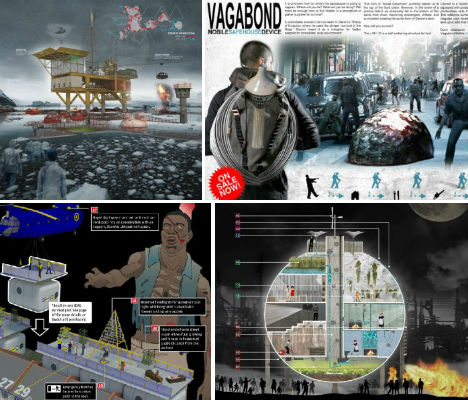
YOU ONLY LIVE ONCE...MAYBE TWICE!
Post your outdoor tips, tricks, and bushcrafting skills here so that others might benifit from your knowledge.
Views: 957
Replies to This Discussion
-
many people do not consider the basics of their nutrition when they plan for survival, if they plan for survival at all.
many people think that simply hunting and providing meat is sufficient, and that "The Buck Stops there" (forgive the pun) however, few people understand that your calories must also consist of certain vitamins and minerals to assure a healthy diet and prevent muscle loss, maintain body fat (yes, it is important) and maintain a strong immune system and high energy.
With that in mind, one of the most overlooked vitamins that we need is Vitamin C. You can get it from a varied number of sources, but few people know how to get it while out living off the land. Without it, you will eventually get sick and possibly die. So, How do you manage to get Vitamin C when you are hunting for any food you can get and are already on the brink of death and starvation... you can't be picky, right?
well, the odds of finding a unspoiled orange grove are slim to none in your area. so that is out.
but did you know that an onion has many times more vitamin C in it than an Orange? or that a jalapeno has many times more vitamin C in it than an Onion?
well, even if those options aren't available to you..... This is my Wilderness survival Tip::
TAKE A SMALL FIST FULL OF GREEN PINE NEEDLES AND BOIL THEM DIRECTLY IN A CUP OF WATER UNTIL THE WATER HAS A SLIGHT GREEN TINT TO IT. DRINKING THIS AND DISCARDING THE NEEDLES WILL ACTUALLY PROVIDE YOU MORE THN ENOUGH OF YOUR DAILY REQUIRED VITAMIN C.
it tastes like ass.... specifically, ass flavored pinesol.. but it works and will help you maintain a strong immune system.
-
8 Common Mistakes of Wilderness Survival!
1. No Shelter
This is a two fold mistake that will cost you your life in a Wilderness Survival Situation. The first fold of this mistake is not having a proper shelter with you, the second fold is not having the knowledge to build a shelter from nature’s tools which are all around you. When talking about someone or a group of people who died in the Wilderness there is a common term that you will hear come up, exposure. Whether it is hypothermia or heat stroke, the bottom line is you either did not have shelter (tent, tarp, sleeping bag with bivvy) or you didn’t have the knowledge to build a suitable shelter to shield yourself from the elements. Remember, Staying Dry is the first rule of Survival.
2. Lack of Good Navigation Tools
People who venture into the Wilderness without a map, compass, and GPS are flirting with disaster. Anyone who has spent time in the woods knows that within seconds even the best woodsman can get turned around in thick trees and bushes and begin to walk the wrong way. The key to navigation is having a back up method to find your way to safety, remember “Two is One and One is None” never rely on GPS alone. Having a good understanding of cardinal directions using the Sun and Stars is also beneficial if you are thrown into a situation where prior preparation wasn’t available (plane crash, boat wreck).
3. Poor Knowledge
“Be Prepared” is the motto of the Boy Scouts, unfortunately most people who find themselves in a Wilderness Survival situation have very poor knowledge on how to survival and are usually totally unprepared.
Know the 5 keys to Wilderness Survival
1. Know how to build a shelter
2. Know how to signal for help
3. Know what to eat & how to find it
4. Know how to build and maintain a fire
5. Know how to find water and prepare safe water to drink.4. Miscalculating the Risk
Most Wilderness Survival situations start off very innocent; like a fishing trip with friends, a day hike on a familiar trail, or a planned father & son hunting trip. Then things go terribly wrong and suddenly you are faced with a life and death scenario. The only thing you can do is plan for the unexpected. Sit down and go through contingencies before you set off on your trip. Once you leave, it is too late. There is an old military saying “Failing to Plan is Planning to Fail.” Make sure you have done this same process with your emergency car kit.
5. The Wrong Clothes
As a rule you should always dress one layer warmer than you need. You can always take stuff off and wrap it around your waist, stuff into your pockets or put it in your backpack if you get hot. But once you leave an article of clothing behind there is nothing worse than being cold knowing that you left your jacket in the closet. Also remember the outdoor sayings about Cotton. (Cotton Kills, Friends don’t let friends wear Cotton, and Cotton is Rotten) Find and wear clothes that retain their warmth even after they become wet. Also have a shell jacket and pants of some kind for rain and snow. Remember, most cases of hypothermia happen in temperatures over 40 degrees Fahrenheit.
6. Getting Drinkable Water
We all know that the human body doesn’t last long without water. The question you have to ask yourself in a Wilderness Survival situation is “Will this water make me sick?” Waterborne organisms such as cryptosporidium and giardia can cause severe diarrhea and vomiting that increases dehydration and reduces your ability to carry on your other survival efforts such as building shelter, finding food, and signaling for help. On the flip side dehydration will kill you in a matter of days. Without a good supply of pure drinking water, the body can become dehydrated very quickly. Along with dehydration comes poor judgment, loss of energy, and eventually you will lose the will to survive. There are several methods for purifying water (Boiling it, Chemical tablets, & Water Filters) and there are several methods for catching rain water or dew. Learn these strategies and be prepared.
7. No Signal Plan
Being able to signal for help is a key trait in Wilderness Survival. If you go to almost any outdoor store they will have a whole section dedicated to these devices. The most common ones are whistles and signal mirrors but you also have to think about being able to use fire starting devices and high beam flashlights. Other good tools to have are radios, bright clothes, and emergency beacon devices such as ACR or SPOT. If you are caught in a Wilderness Survival situation without any of these tools, have an understanding for creating an emergency signal using rocks, trees, snow, or dirt.
8. Fire
It is only one word but in Wilderness Survival it has many meanings. Warmth: a good fire can keep you and your loved ones warm in some of the worst conditions. Protection: a strong fire can keep you safe from predators and a long burning stick has scared more than one animal away. Signal: a blazing fire can be seen for miles away at night and the smoke can be seen during the day. Purifier: a hot fire can be used to boil water and keep your drinking water safe. Keep several methods of making a fire with you when traveling in the Wilderness and also learn how to make a fire the old fashion way……with two sticks.
-
There are multiple ways in which you can make a fire, but the question of how WELL you make a fire is often brought up. fires cause multiple problems. fuel shortage, smoke and light visibility... if you are attempting to evade notice, many times a bright fire at night will get you killed. but if people are hunting you, then you can't even cook in the daytime as the smoke will signal your hunters. so what do you do? simply not build a fire?
THE ANSWER IS A DAKOTA FIRE HOLE
It concentrates your fire underground, insulating it so that your fire is hotter, but burns less fuel. This is a big deal because where i live in texas, there often isn't enough wood for making fires on the great plains of the Panhandle. i was gonna write out an essay, but i found an article on how to build one that is very trustworthy. I've used Dakota Fire Holes since i was a child in Boyscouts, and The article is almost word for word spot on.
-
WHAT SHOULD YOU DO IF LOST OR STRANDED???
Do you know the difference between "lost" and "stranded?" Lost is not knowing where you are nor which way you should go. Stranded is [usually] knowing where you are but no one else seems to know where you are. Now according to most survival books, websites and search & rescue (SAR) teams...
RULE # 1 - Before you take off and go anywhere you should tell someone (a) where you are going and (b) what time you will be back or be arriving at your final destination. Just in case you don't make it back or to your final destination within a certain time a search and rescue (SAR) party will know where to start looking for you.
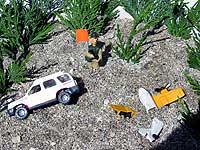
RULE #2 - Should you become lost or stranded in a disabled vehicle or you're a survivor of a plane crash, it's best to remain with the vehicle or plane. As it will be easier for a SAR party to find you in a stationery position than to look for a moving person or a group of people who have no idea where they are going.
But if there's no vehicle or plane and you are on foot and you have no idea where in the hell you are or which way you should go. Then again, it's best to stay where you are as it will be easier for a SAR party to find you in a stationery position then to try to look for you wandering around aimlessly not knowing where in the hell you are going.
But if you broke RULE # 1 - Failed to tell someone where you are going before you took off.. Then you can skip RULE # 2 and proceed directly to RULE # 3 - DON'T PANIC & LOSE YOUR HEAD, S.T.O.P ! S top moving, sit down and relax, T hink where you may have screwed up, O bserve your surroundings and try back tracking a little bit to see if you can recognize the terrain. And if you don't, sit down, take a deep breath and admit to yourself... "Well it looks like I'm lost, what should I P lan to do next?"
Well for starters you should listen up for signs of civilization. Such as listening for sounds of vehicles, trains, church bells, factory noise, etc that will give you a general sense of direction as to which way is civilization. But if you don't hear anything, then look around and proceed to the nearest and highest piece of ground and from there look for buildings, towns, church steeples, roads, railroad tracks, fences, power lines, telephone lines, etc that will lead you back to civilization. If there's no high ground then climb the nearest and tallest tree.
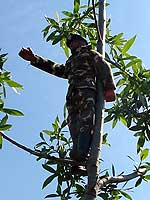
But again if you don't see or hear any signs of civilization but you see a stream, creek or river, then follow that instead. As it will not only provide you a source of water for drinking but will most likely lead you back to civilization or to some trails or roads that will get you back to civilization. But should you be on the move and you don't see or hear anything that can help guide you back to civilization and the weather starts to change, the temperture begins to drop and or darkness is quickly approaching. Then it's best to stop and stay where you are for the night and begin building a shelter and getting a fire going before it's too late than to risk getting wet, cold and not seeing where you're going. And as you read on you will not only learn from me how to build a shelter and start a fire but to survive, thrive and to teach others how to do it too.
-
Making Arrowheads:
The Art of Flint Knapping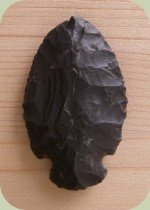
By Jason Knight
Flint knapping is the age-old art of making arrowheads and other edged stone tools. Hunter-gatherers relied upon this key wilderness survival skill to create important tools and hunting implements. Many people continue to practice the skill today, including traditional bowyers, experimental archaeologists, and primitive skills enthusiasts.
At its most basic level, flint knapping consists of: breaking open a piece of parent material (called a core); striking flakes off of that core; and then shaping those flakes into the intended tool.
In general, the process of making arrowheads includes the following primary concepts:
- Safety and Ethics
- Choosing the Proper Materials
- Percussion Flaking
- Pressure Flaking
- Notching
Safety and ethics of making arrowheads
Because flint knapping includes breaking apart rocks with force, where sharp flakes can fly off in any direction, it is very important to wear safety glasses. Gloves, shoes, and sturdy pants are also highly recommended. It is also important to flint-knap in a place where you can easily catch the sharp flakes that will fall to the ground (so that they are not accidentally stepped-on). You can put down a tarp or sweep up afterwards. Also, use a well-ventilated area, so not to breathe the dust created by breaking rocks.
When it comes to the ethics of flint knapping, the primary concern is to be mindful of the archaeological record. To an archaeologist, piles of flaked stone (debitage) can indicate the presence of an ancient village or camp. To prevent your work from being confused as archaeological evidence, always add a penny or two to your pile of debitage and be sure to sign and date your completed work with a diamond-tipped pen.
Choosing the proper materials
The best stones for making arrowheads include flint, chert, obsidian, jasper, quartzite and other stones that are somewhat brittle and have a fine-grained, uniform texture that is free of cracks, fissures, and fractures. Glass and porcelain can also be used. You can also tap the stone and listen to the pitch. Stones that produce a higher pitch when tapped are generally better for knapping.
To break apart and shape your material you will be using some simple tools for percussion and pressure flaking. These tools can be made out of antler, soft metal, soft stone, bone, or very hard wood. The best pressure flaking tools are made with an antler or copper tip.
Percussion flaking
Percussion flaking is the act of striking your material to break it apart in a controlled manner. In a uniform material, the force from a strike moves out from the point of impact in a cone shape that is roughly 100 degrees wide. This is called a Hertzian Cone (see figure 1). Understanding this concept of how forces move through stone allows you to angle your stone to break it apart in an intentional way.
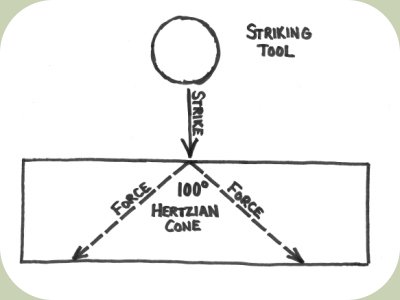 Figure 1
Figure 1
If your parent material (also called a core) has rounded edges, the first step is to break it apart so that you have good edges to work with. This can be done by using a large hammering tool. The goal is to create platform edges that are less than 90 degrees (see figure 2).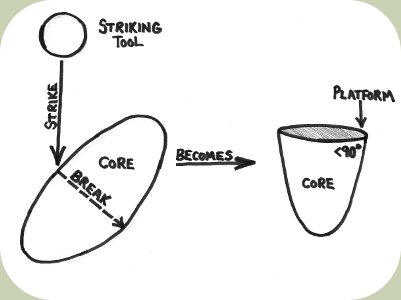 Figure 2
Figure 2
The next step is to strike flakes off of your core using smaller striking tools. It is these flakes that you will be further shaping into implements such as arrowheads (see figure 3).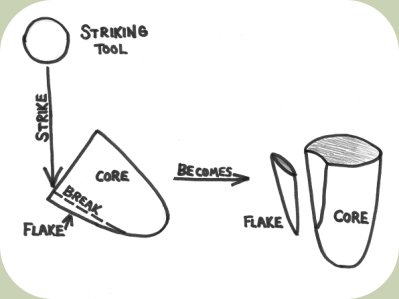 Figure 3
Figure 3Pressure flaking
Pressure flaking is the act of using a pressure flaking tool (such as an antler) to load significant pressure against an edge and then popping off a long thinning flake. Pressure flaking allows a flake to be carefully shaped down into the finished tool.
To pressure flake, an edge often needs to be strengthened by abrading it to remove thin weak pieces. A platform is then picked out, which is a point on the edge that sits below the centerline of your flake. The pressure flaking tool is then pushed onto the platform with significant force and a small thin flake is popped off of the piece (see figure 4).
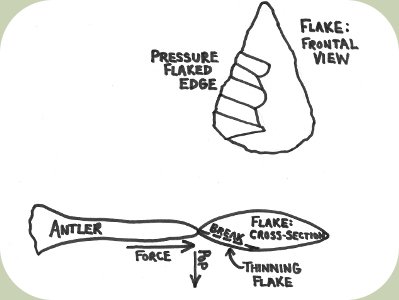 Figure 4
Figure 4Notching
Notching is the final step in making arrowheads. The notches are made using a combination of pressure flaking and abrading to carve out the gaps that allow the arrowhead to be bound to an arrow shaft (see figure 5).
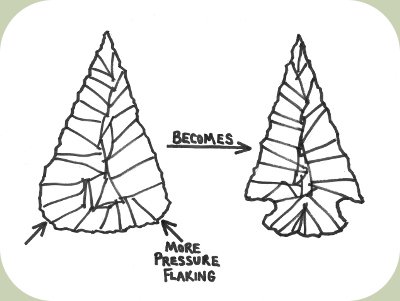 Figure 5
Figure 5
You now have a completed arrowhead. You can haft it onto an arrow shaft and begin working on another. Happy knapping!
-
What you suggest for a underground shelter?
-
it would depend, for an underground shelter. there is alot of things that i would dislike about one in a temporary setting. collapse, getting trapped, etc. it's a pretty high risk venture.
however,there is alot of benefits to having one, mostly due to the temperature control of having one. for a temporary solution, if i had the ability, i would use a solid 55 gallon drum or other solid box, if i were to come across one, and bury it from there. (keep in mind, i am only thinking temporary, as any time you are stationary, you should consider far more permenant options)my reasoning is due to the location i live. i am in the south, (north texas to be exact) and the heat and desert plains conditions are bad enough to kill. 120 degrees at the high in summers being out in the open with no shade will definately kill if unprotected.
My typical solution for shelter in these conditions can be solved with the use of carrying 2 large tarps with you instead of a tent. (tents are heavy and bulky, even a single person backpackers tent is sometimes not worth the effort) tarps are multi use in several ways.
firt, you set up one tarp like a tent, low to the ground, 2-3 feet is all. where you can be on hands and knees, but not much higher than that. 2nd, you erect your 2nd tarp into a tent about 2 feet above the first one. you should make sure your tent openings coordinate with the wind to maximize air flow. 3rd, you dig out the top 4 inches of top soil from inside the tent. it is said that removing this sun baked earth and exposing the cooler ground will lower the temperature inside the tent by almost 20 degrees.
the top tent blocks most of the sun so that the 2nd tent can provide better shade, block the rest of the sun that filters through, without radiating heat off of it. i've used this method several times when friends hiking risked getting heat stroke and were close to passing out.
-
12 Futuristic Finalists: Zombie Safe House Competition
When the zombies come, nobody’s going to save you but yourself. This idea has zombie apocalypse survivalists designing amazingly complex safe houses from compact extending shells you can carry on your back to entire fortified neighborhoods complete with electrified lawns and zip lines. Architects Southwest sponsored this year’s ‘Zombie Safe House’ competition, and these top 12 winning designs might just prompt you to think about how well you’d do in your own home. Check out the remaining 5 finalists and the rest of the entries at ZombieSafeHouse.wordpress.com.
Vagabond Mobile Safe House Device
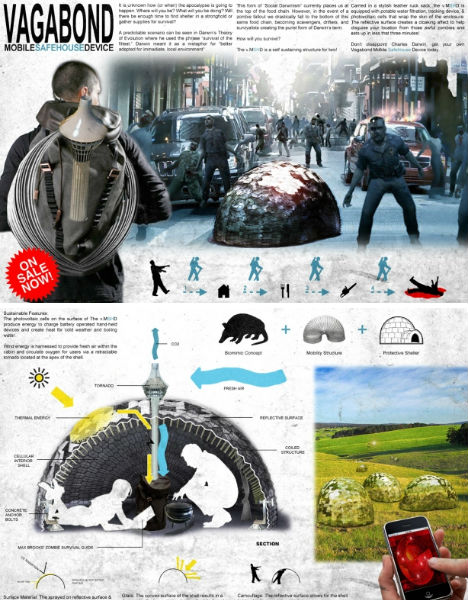
(images via: zombiesafehouse)
Snagging the 1st place ‘Gold Shovel Award’, the Vagabond Mobile SafeHouse Device is a self-sustaining structure for two that can be carried on your back in a stylish rucksack. Containing potable water filtration systems, a tracking device and photovoltaic cells that form a tough skin, the shelter folds out into an instant protective shell that can be set up in less than three minutes. Creator ‘snd’ predicts that in a zombie apocalypse, only those who adapt immediately will survive a la Social Darwinism. “Don’t disappoint Charles Darwin, get your own Vagabond Mobile SafeHouse Device today.” If only.
Oil Silo Home
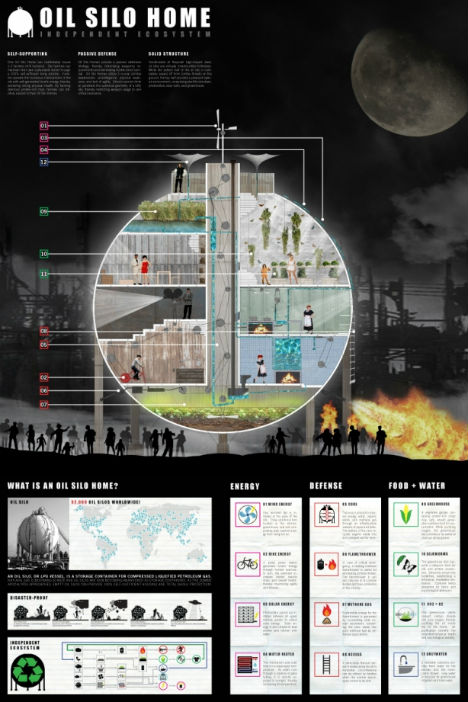
The 2nd place ‘Silver Machete Award’ goes to the Oil Silo Home by PinkCloud.DK. This self-supporting design makes use of the 52,000 oil silos that already exist worldwide. Disaster-proof, these structures can provide an ‘independent ecosystem’ when equipped with wind, solar and bike energy as well as a greenhouse, silkworms for fabric and greywater recycling. The best part of the Oil Silo Home is its ‘passive defense’ design, which uses existing oil and methane gas as weapons against invading zombies.
Look.Out.House
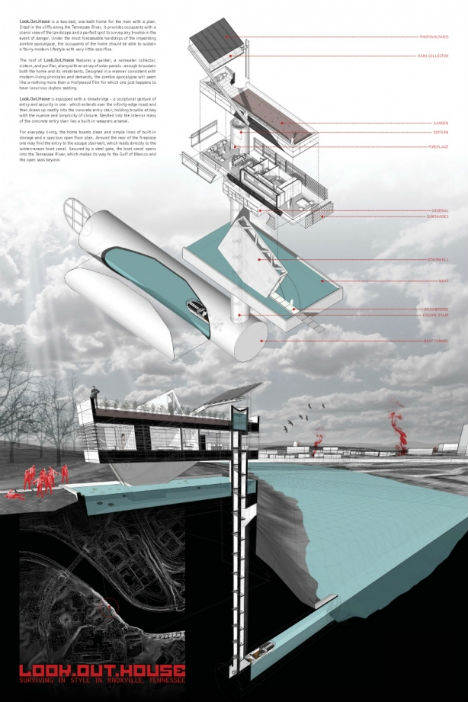
When faced with the worst-case scenario, who wouldn’t want a stylish modern home that is eminently livable yet also practical for survival? The Look.Out.House is imagined for a riverfront location that provides a scenic view of the landscape and an ideal vantage point to watch for zombie invaders. It includes a rooftop garden with a rainwater collector, cistern and purifier, solar panels and a lovely open floor plan. Major advantages include a drawbridge extending over an infinity-edge moat, a built-in weapons arsenal and a subterranean boat canal leading to the river.
“Designed in a manner consistent with modern-living principles and demands, the zombie apocalypse will seem like nothing more than a Hollywood film for which one just happens to have luxurious skybox seating.”
Zombie-Proof Your Home
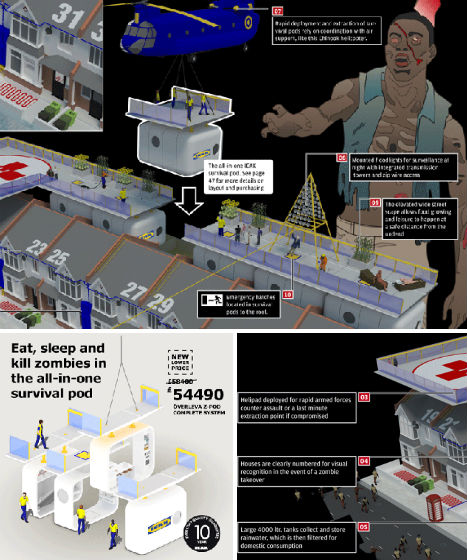
Need to ‘bug in’ – meaning, stay at home rather than trying to flee to safer locales? You’d better make sure your house is as zombie-proof as can be. This plan by Jordan Lloyd and Roger Cooper outlines each step you must take to equip your existing home with zombie-defending features that could be sold in big box stores like IKEA. Suggestions include biodiesel for power, a ground source heat pump that can electrocute any zombies in your yard, a helipad for rapid armed forces counter assault, large rainwater tanks and zip wires that allow residents to quickly move to other streets without descending to ground level.
Zombie Ranch
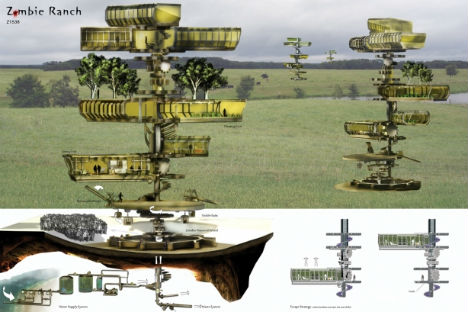
(images via: zombiesafehouse)
Not only would you be living the high life at the Honorable Mention-winning Zombie Ranch – literally – the very brain-seeking creatures that are out to destroy you would help power it. Drawn to visible baits, zombies turn a giant wheel in order to get to them. Thankfully, they’re not quite smart enough to see how they’re being used (or are they?) The unit has a retractible bridge so that occupants can get in and out, and includes space to grow food as well as living units.
SafetyNet City
“High above, safe from the deadly streets below, we have started anew. We live in a city of nets, steel cables strung between the dead relics of forgotten skyscrapers.” This is how contest entrants Mihaly Slocombe Architects envisions surviving the zombie apocalypse – in hanging pods packed with rations and weapons, offering excellent visibility of the carnage below. Draped between parallel strands of the nets are plastic membranes, which support the various industries and functions needed for survival including rain capture and growing food.
Pre-Fabricated Shelters
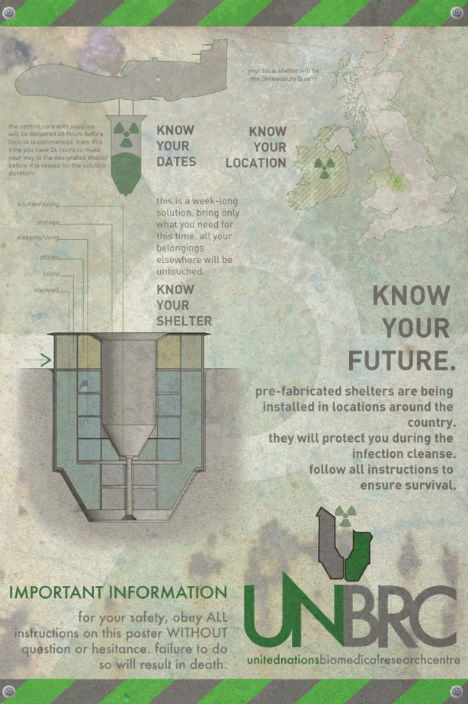
Just as we have public shelters for natural disasters, this entry imagines giving each local area its own zombie survival shelter. Located underground, the shelter will enable those not yet infected to get to a safe place and be sealed inside with all the supplies needed to live “during the infection cleanse.” You hang out underground for a while, and when you come back up, the zombies are gone. Hard to argue with that.
Zombie Emergency Rapid Deployment Shelters
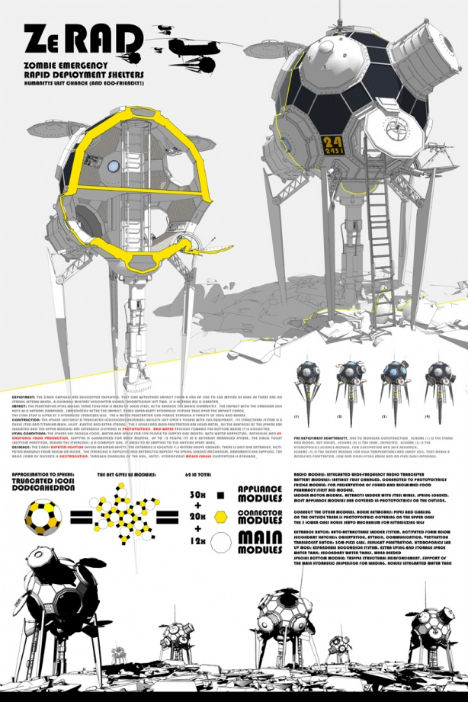
(images via: zombiesafehouse)
On the other hand, if there’s a zombie outbreak, it would be nice if the shelter could come to you. Yet another Honorable Mention entry, the ZeRAD – Zombie Emergency Rapid Deployment Shelter – gives humanity one last chance to survive. Helicopter-deployed mobile modules with penetrator spikes heavier than the spheres are dropped to the ground. The spikes secure them so they can withstand a heavy assault. Each sphere has enough food, water and space for five people to survive for one month, with additional water harvesting capabilities. And if any zombies try to climb up, they’ll be fried by the electrified hull.
LifeBuoy
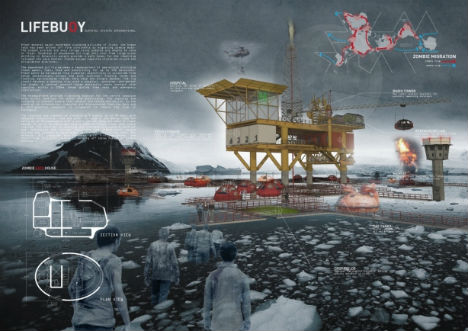
Imagine a zombie-infested future where the outbreak is so bad, we can’t even live on land anymore. If it gets to that point, LIFEBUOY has us covered. This design makes use of abandoned oil rigs, turning them into entire floating complexes that include crop fields, radio towers, markets, food storage and a hospital. Each rig can support 500 survivors.
Statue of Liberty Shelter
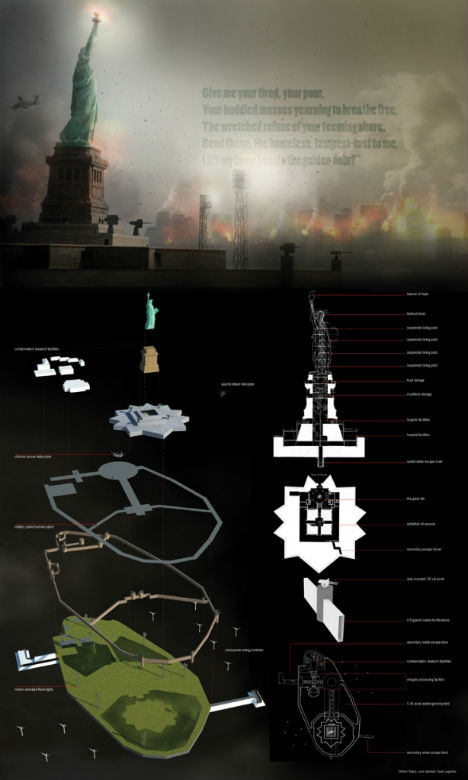
The Statue of Liberty has long been one of the first sights glimpsed by immigrants into America, and one day, it could literally offer a safe haven of survival. The torch becomes a ‘beacon of hope’, while the rest of the statue includes a lookout point, living pods and storage space for food and munitions.
Dam City
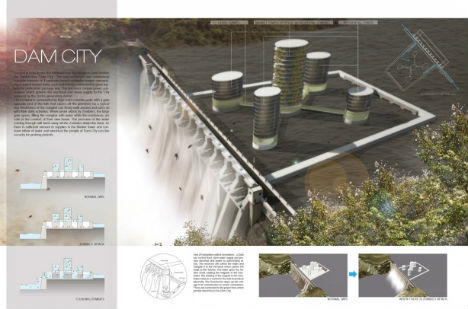
Again taking advantage of the fact that zombies (theoretically) can’t swim or float, Dam City places a new civilization across the Krishna River in India at the Srisailam Dam. Using the existing dam as a base, the civilization adds four concrete residential towers surrounding a central market tower. Each tower is connected with glass tunnels for pedestrians, and the dam provides the power. When under attack, the dam gate opens, filling the complex with water to wash the zombies down the side of the dam.
Ark-Class Interstate Sweeper
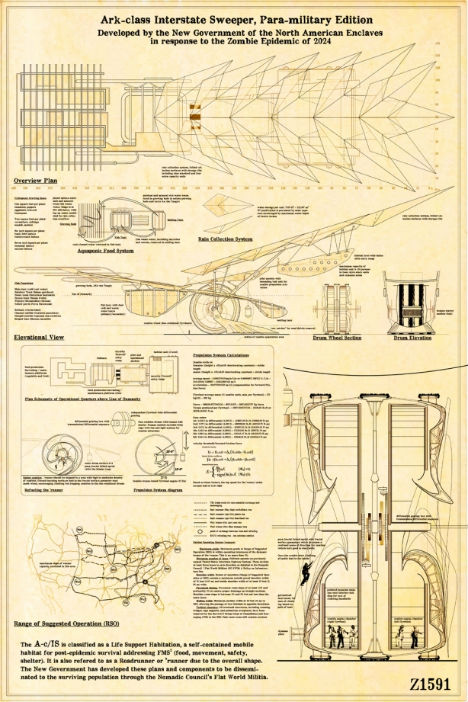
Not only is this ‘Ark’ just what it implies, with enough space, supplies and technology to support what uninfected humans may remain, it also sweeps zombies right out of the streets as it moves. Features include an aquaponic food system and rain collection system. The Ark moves along the interstates to locate and save survivors.
-
These are cool, tbut they imply a permanency that i'm not sure i support. mostly because they aren't self sufficient. you will need massive money to get these before the zpoc... and then eventually you will need to sustain your food supplies, so you will have to go topside anyway.
the money spent for an underground shelter would better be used setting up a protective perimeter around your land that is zombie proof, allowing you a safe zone to grow crops, raise animals, and create a city-state of independant people to thrive long term.
also, there is an example to better explain... "is it better to hide in the basement, or the attic from a zombie apocalypse? always the attic. you can cut your way through the roof to escape... the basement is a coffin with only 1 way out....
-
Born Survivor: Bear Grylls
Survival Tips
Survival Tip 1: Out in the wild, finding water is of paramount importance. However, taps are not generally found in the wild, therefore you may have to rely on stranger, more disgusting sources of water. In North Africa, Bear Grylls uses his own urine as a source of hydration. By peeing into a shirt he can collect the water and use it to cool himself down, as well as rehydrate his mouth. Yum!
Survival Tip 2: If you happen to be stranded on a desert island, pray that you have access to some bamboo trees. Bamboo is extremely versatile: it’s very buoyant and it does not absorb much water, meaning it takes a lot for it to rot; perfect for making a raft and sailing yourself to freedom.
Survival Tip 3 If the heat doesn’t get you, the snakes, crocodiles, spiders and scorpions will. Northern Australia’s Arnhemland is a dangerous place, so knowledge of traditional aboriginal survival techniques is vital. Need food? Snakes are a useful source of protein, and aboriginal warriors have developed a trick where they can break a snake’s neck with their mouth – but be careful, the last thing you want is to get bitten in the face.
Survival Tip 4 If you find yourself in a sand storm try not to panic. Your first worry is suffocation, so try and cover your airways with a cotton t-shirt, It may not be perfect but it could save your life. The biggest particles of sand are at the bottom of the storm with the fine particles blowing at the top, that is what will suffocate you, so try and keep low. Also, you won’t navigate yourself out of a sandstorm that could last for hours, so hunker down and wait for it to pass.
Survival Tip 5 One the biggest reasons people die in blizzards is that they push on and try to battle the limitless fury of Mother Nature. Your number one priority when in a blizzard is from the wind and the cold. Cover up any exposed skin, in high freezing winds frostbite can set-in in minutes. Out in the frozen tundra there may not be any natural shelter so digging a snow hole can be the difference between life and death.
Survival Tip 6 The battle in the frozen wastes is to stay warm and dry; once you get wet your body starts to lose heat up to 20 times faster! After taking a lengthy swim in a frozen Lake, Bear had to kick into survival mode if he wanted to make it out alive. The most important thing was to get dry. Jumping out of a frozen river naked and wet and into your clothes is only going to make your clothes wet. If you don’t have access to a towel, and odds are you won’t, rolling around in fine snow will absorb excess water. After you’ve got your clothes back on you’ll want to get a fire started and increase your core temperature as soon as possible.
Survival Tip 7: Found yourself stuck in Norway with nothing to eat? Maybe you should set traps and hunt for deer. Not only can you use their super thick fur and hide for insulation, it also has over 100,000 calories, enough to last you two weeks, moreover in the cold we need twice as many calories to survive; for men that’s 6000 calories! The super-rich dear meat could save your life.
Survival Tip 8: Need a wetsuit? Try looking for a dead seal. In Norway, by skinning a dead seal and using its well-insulated hide, Bear crafted himself a wetsuit that allowed him to swim frozen waters and still stay (relatively) warm.
Survival Tip 9: Fire is the be all and end all when it comes to survival. Not only does it help keep you warm but allows you to purify your water, cook your food and keep pests and other wild animals away. So whether you use a bow drill, an aluminum soda can and a bar of chocolate or even a flint and steel, fire is every adventurer’s best friend.
-
Sleeping in with an upside down Fire.
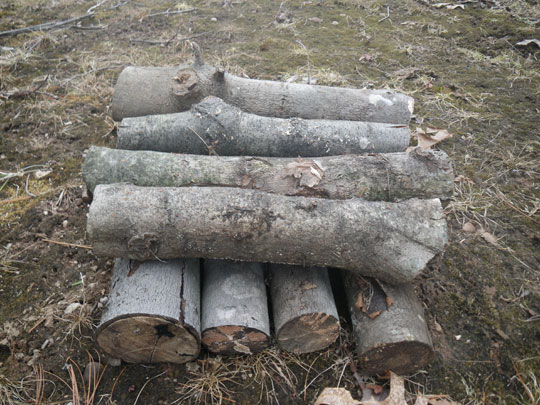
-
this is a very good idea. i haven't had much need to use it, but it's a great solution for northern or wet climates as well
© 2025 Created by Komrad Venessa Wicked☭.
Powered by
![]()




